The Moon Returns After New, An Extra-close Jupiter Sports Spots, and Mars Cruises by a Cluster!

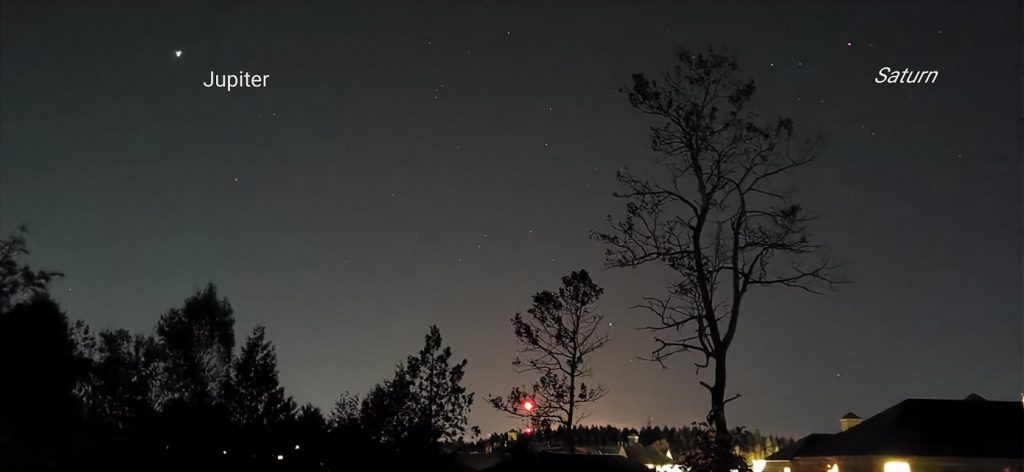
Getting ready for Monday’s close Jupiter opposition, Chris Curwin of Astronomy by the Bay in Saint John, NB recently captured the gas giant planets in evening with his Hauwei smartphone. Chris is very active in astronomy outreach in Southern New Brunswick. Find out about his events at http://sjastronomy.ca/ or watch his streams on YouTube at https://www.youtube.com/c/AstronomybytheBay/featured
Hello, Early-autumn Stargazers!
Here are your Astronomy Skylights for the week of September 25th, 2022 by Chris Vaughan. Feel free to pass this along to your friends and send me your comments, questions, and suggested topics. You can also follow me on Twitter as @astrogeoguy! Unless otherwise noted, all times are expressed in Eastern Time. To subscribe to these emails please click this MailChimp link.
If you’d like me to bring my Digital Starlab portable inflatable planetarium to your school or other daytime or evening event, or deliver a session online, contact me through AstroGeo.ca, and we’ll tour the Universe, or the Earth’s interior, together! My terrific book with John A. Read entitled 110 Things to See With a Telescope is a guide to viewing the deep sky objects in the Messier List – for both beginners and seasoned astronomers. DM me to order a signed copy!
Today’s new moon will trigger Rosh Hashanah for Jews. The morning zodiacal light will continue to be visible from very dark sites. The young moon will wax as a pretty crescent in the western sky after sunset all week long, beckoning views of it in binos and scopes. Mercury will join bright Venus low in the pre-sunrise sky. Jupiter will shine its biggest and brightest in 70 years on Monday night, and its moons will be scurrying across its disk. Meanwhile the other outer planets will remain observable in evening, including late-rising Mars as it passes a star cluster. Read on for your Skylights!
Rosh Hashanah
“Shanah Tovah!” to my Jewish friends. In a lunisolar calendar, each month begins at sunset on new moon, or with the first glimpse of the young crescent moon after its new phase. Nissan 1, the first day of the year in the Jewish lunisolar calendar begins at the new moon closest to the March Equinox in northern spring. The Jewish calendar’s seventh month, named Tishrei, always falls in September or October on the Gregorian calendar. Tishrei hosts the Jewish High Holidays – Rosh Hashanah, Yom Kippur, Sukkot, Shemini Atzeret, and Simchat Torah.
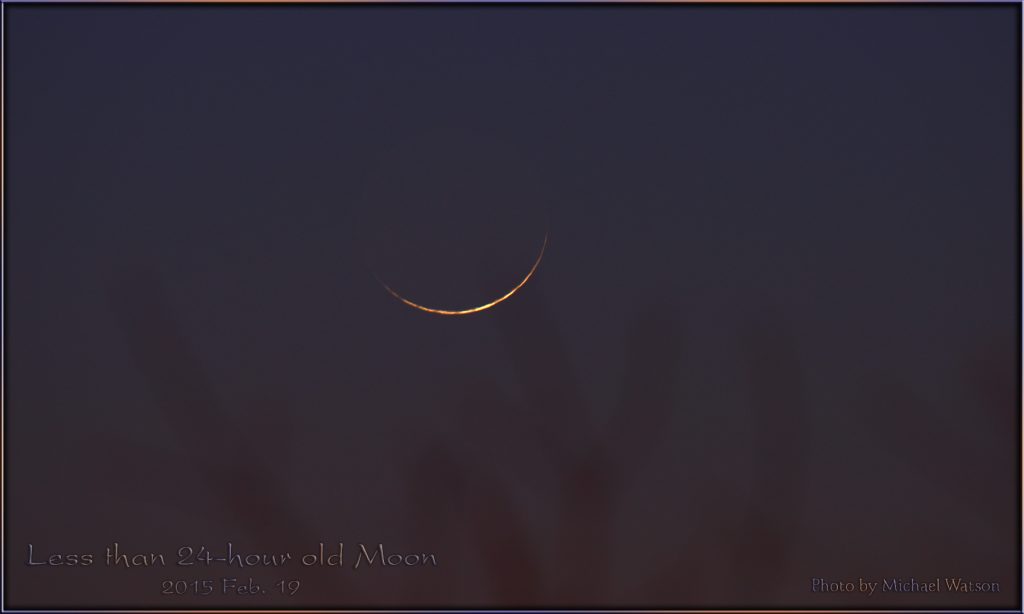
Rosh Hashanah, or the religious Jewish New Year, commences at sunset on Tishrei 1 (Sunday, September 25) and ends after nightfall on Tishrei 2. By ending the celebration after nightfall, it spills into Tishrei 3 (September 27), making it a 2-day event – probably because determining when the new moon occurred was difficult before modern astronomical tools. Rosh Hashanah occurs 163 days after Passover, so it often uses the new moon closest to the September equinox, which occurred last week.

The name can be translated to “Head of the year”. Jews celebrate the creation of the world and mark the beginning of the Days of Awe, a 10-day period of introspection and repentance that culminates with the Day of Atonement, Yom Kippur on Wednesday, October 5. The traditional greeting during Rosh Hashanah is the phrase “Shanah tovah”.
The Moon
The moon will gradually return to view in the western evening sky worldwide this week – but tonight (Sunday) at 5:54 pm EDT or 2:54 pm PDT and 21:54 Greenwich Mean Time, the moon will reach its new moon phase. At that time our natural satellite will be located in Virgo (the Maiden), just 2.5 degrees north of the sun. While new, the moon is travelling between Earth and the sun. Since sunlight can only illuminate the far side of the moon, and the moon is so close to the sun in the sky, it becomes completely hidden from view from anywhere on Earth for about a day.
The first glimpse of the young crescent moon will be possible immediately after sunset on Monday, when its 1%-illuminated crescent will be swimming in the thick air above the western horizon. On each subsequent night this week, the moon will increase its angle from the sun, and its visibility, because it will be setting about half an hour later and waxing fuller and brighter.
By Wednesday, the moon will be lingering long enough into evening to see it in a dark sky. It’ll also be high enough to enjoy clear views of in any telescope without trees and rooftops obstructing your view. The curved boundary that separates the lit and unlit hemispheres is called the terminator. Along that line, the sun is just clearing the lunar horizon. The near-horizontal rays of sunlight landing there cast long shadows to the west of every topographic feature, throwing them into stark relief. Night-by-night, and even hour-by-hour, the terminator creeps west, highlighting new zones. Some subtle structures on the moon, like wrinkled lava flows or dorsae in the dark mare regions, can only be seen when the terminator is near them.
The Earth’s own terminator sweeps over us at sunrise and sunset every day. Except for times when Mars appears ever so slightly less than full in telescopes, only the moon, Venus, and Mercury display phases, and terminators to earthbound observers. Keep your binoculars and telescopes handy by the door all week and grab views of the moon frequently. Watch the moon’s terminator curve less each night until it becomes a straight line next Sunday at the first quarter phase. That phenomenon suggested to the ancients that the moon was a sphere.
If you have the binoculars or telescope outside on Wednesday night, look for the bright star positioned about two finger widths to the moon’s upper left (or celestial east). That star is Zubenelgenubi, or Alpha Librae, the second brightest star in Libra (the Scales). Under magnification Zubenelgenubi splits into a double star – a pair with one star shining several times brighter than the other.
On Thursday, the crescent moon will hop into eastern Libra to shine just to the right of an up-down row of small white stars that mark the claws of next-door Scorpius (the Scorpion). Libra’s stars Zubenelgenubi and Zubeneschamali (the brightest star in Libra) used to mark the scorpion’s claw tips until those star were transferred to make Libra. Their names mean northern and southern claw.

On Friday evening, the crescent moon will shine only a thumb’s width above (or 1.5 degrees to the celestial northeast of) the bright, reddish star Antares in Scorpius. Antares is located just 4 degrees south of the ecliptic. That means that the moon, and even the occasional planet, can pass in front of (or occult) it. Antares’ name arises from an ancient Greek expression for “rival to Ares”, which we know better as the planet Mars.
The moon will spend the first night of October (already!) tickling the toes of Ophiuchus (the Serpent-Bearer). The medium-bright stars named Guniibuu, Garafsa, b Ophiuchi, c Ophiuchi, and Aggia, all twinkling to the moon’s upper right, mark his eastern foot.
The moon will formally complete the first quarter of its journey around Earth on Sunday, October 2 at 8:14 pm EDT or 5:14 pm PDT. (That translates to Monday, October 3 at 00:14 GMT.) That night the half-illuminated moon will steep among the leaves inside Sagittarius’ Teapot shape – but you can see the moon in daylight from mid-afternoon onwards.
Morning Zodiacal Light for Mid-Northern Observers
During autumn at mid-northern latitudes every year, the ecliptic extends nearly vertically upward from the eastern horizon before dawn. That geometry favors the appearance of the faint zodiacal light in the eastern sky for about half an hour before dawn on moonless mornings. Zodiacal light is sunlight scattered by interplanetary particles that are concentrated in the plane of the solar system – the same type of material that produces meteor showers. It is more readily seen in areas free of urban light pollution. For observers at low latitudes, the ecliptic is nearly vertical all year round, making the light a frequent phenomenon. Sadly, observers north of 60°N latitude miss out.
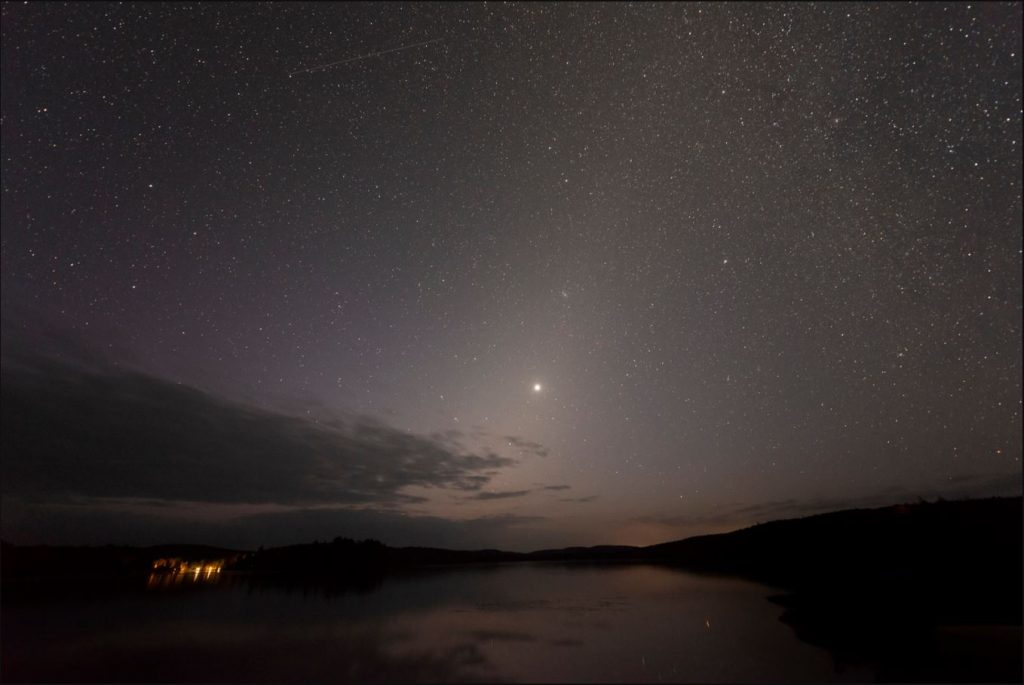
If your location favours it, between now and the full moon on October 9, look for a broad wedge of faint light extending upwards from the eastern horizon and centered on the ecliptic. It will be strongest in the lower third of the sky, below the twin stars Castor and Pollux. Try taking a long exposure photograph to capture it. Don’t confuse the zodiacal light with the Milky Way, which is positioned nearby in the southeastern sky.
The Planets
After passing its conjunction with the sun last Friday morning, Mercury will join much brighter Venus in the morning sky this week, shining just above the eastern horizon before sunrise. On Monday and Tuesday morning, Mercury will be positioned several finger widths to the right (or celestial southwest) of Venus. For the rest of the week, Mercury will climb higher while Venus descends sunward. Mercury’s latest apparition will be a terrific one for Northern Hemisphere observers, but a poor one for anyone located well south of the equator. Towards the end of this week, the best viewing time for Mercury at mid-Northern latitudes will be 15 minutes starting around 6:30 am local time. Be sure to turn all binoculars and telescopes away from the horizon before the sun rises.

The outer planets, from Mars to Neptune, will all be shining in the evening sky. The medium-bright, yellowish dot of Saturn will become visible in the lower part of the southeastern sky by 8 pm local time. Much brighter, whiter Jupiter will gleam way down to Saturn’s lower left. The ringed planet will be creeping slowly westward above the medium-bright stars of Capricornus (the Sea-Goat) until late October. Saturn trip across the night sky will end in the west-southwest before about 3 am local time. Since the planets always look their best in a telescope when they are higher in the sky, Saturn’s peak viewing time will be around 10 pm, when it will shine in the south – but you can enjoy less-than-perfect views from dusk onwards.
Even a small telescope will show Saturn’s subtly banded globe encircled by its glorious rings, which will become more edge-on to us every year until the spring of 2025. This year Saturn’s southern polar region has already extended well beyond the ring plane. See if you can see the Cassini Division, the narrow, dark gap that separates Saturn’s main inner ring from its bright outer one. Over the coming weeks, Saturn’s slide to the west of the anti-solar point will cause the planet’s globe to cast a widening wedge of dark shadow onto the rings where they emerge from behind the eastern limb of the planet. Where you find that shadow will depend upon how your telescope flips and/or mirrors the view. In a refractor or SCT telescope, it’s toward the upper right. In a Newtonian reflector, it will be toward lower right. An equatorial mount will rotate the scene, too. For best results, take long looks and wait for moments of perfect clarity.
A small telescope can also show several of Saturn’s moons – especially its largest, brightest moon, Titan! From here on Earth, Saturn’s axial tilt of 26.7° lets us see the top of its ring plane, and allows its brighter moons to array themselves all around the planet. Saturn’s largest and brightest moon Titan never wanders more than five times the width of Saturn’s rings from the planet. The much fainter moon named Iapetus can stray up to twelve times the ring width during its 80-day orbit of Saturn. The next brightest moons Rhea, Dione, Tethys, Enceladus, and Mimas all stay within one ring-width of Saturn. During evening this week, Titan will migrate counter-clockwise around Saturn, moving from the lower left (or celestial east) of Saturn tonight (Sunday) to the upper right (or celestial west) of the planet next Sunday. (Remember that your telescope might flip that view around.) How many of the moons can you see in your telescope?
This week, Jupiter’s extremely bright, white dot should clear the eastern rooftops by around 8 pm local time, and then spend the night shining below the modest stars of Pisces (the Fishes). Jupiter will climb highest at 1 am local time, but it will look nice in any telescope after 9 pm. Early risers can spot the planet shining just above the western horizon before dawn.
On Monday night, Jupiter will reach opposition for 2022. Oppositions happen when Earth crosses the imaginary line that connects a planet to the sun. That minimizes our distance from that object and causes it to shine brightest in the sky and appear largest in telescopes. Planets at opposition also rise at sunset, remain visible all night long, and set at sunrise.
All planets have orbits that are elliptical, causing them to move closer and farther from the sun. The minimum and maximum of those distances are known as perihelion and aphelion, respectively. Jupiter takes 11.862 Earth-years to orbit once around the sun, and its next perihelion will occur in only a few months, on January 20, 2023. Meanwhile, Earth’s aphelion occurs every year around July 4. Crunching the numbers, Monday’s opposition will occur while Jupiter is almost nearest the sun and Earth is still quite far from the sun, minimizing the separation between our two planets. In fact, we haven’t been this close to Jupiter since 1963, and we won’t be this close again until 2129!
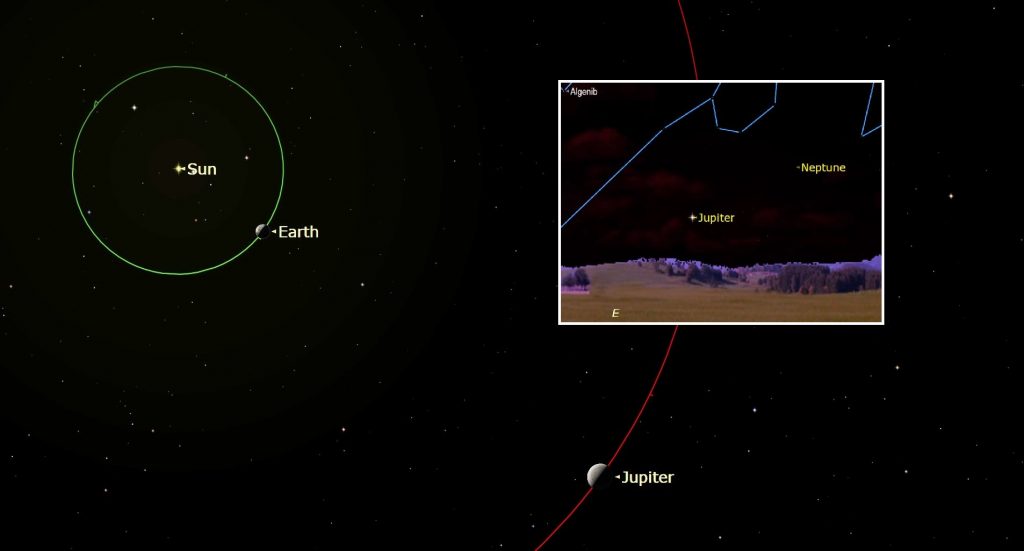
On opposition night, Jupiter will be 591.3 million km, 3.95 Astronomical Units, or 32.9 light-minutes from Earth, and it will shine at its maximum brightness of magnitude -2.94 for 2022. In a telescope, the planet will sport a generous, 49.9 arc-seconds-wide disk. Make an effort to see the planet on Monday, or on the nearest clear night. (Views a night or two on either side of opposition will be just as good.)
As always, good binoculars will show Jupiter’s disk flanked by its row of four Galilean moons Io, Europa, Ganymede, and Callisto, which complete orbits of the planet every 1.7, 3.6, 7.2, and 16.7 days, respectively. If you see fewer than four of them, then one or more is crossing in front of or behind Jupiter – or lurking in Jupiter’s dark shadow – or two moons are occulting one another. Any size of telescope will show Jupiter’s dark bands running parallel its equator.
Because Jupiter rotates once every 10 Earth-hours, anyone can use a good backyard telescope to watch the pale-looking Great Red Spot cross the planet every 2nd or 3rd night. For observers in the Americas, the GRS will cross Jupiter’s disk on Monday, Wednesday, late Friday, and early Saturday evening, and also before dawn on Tuesday, Friday, and Sunday morning. If you have any coloured filters for your telescope, try enhancing the GRS with them.
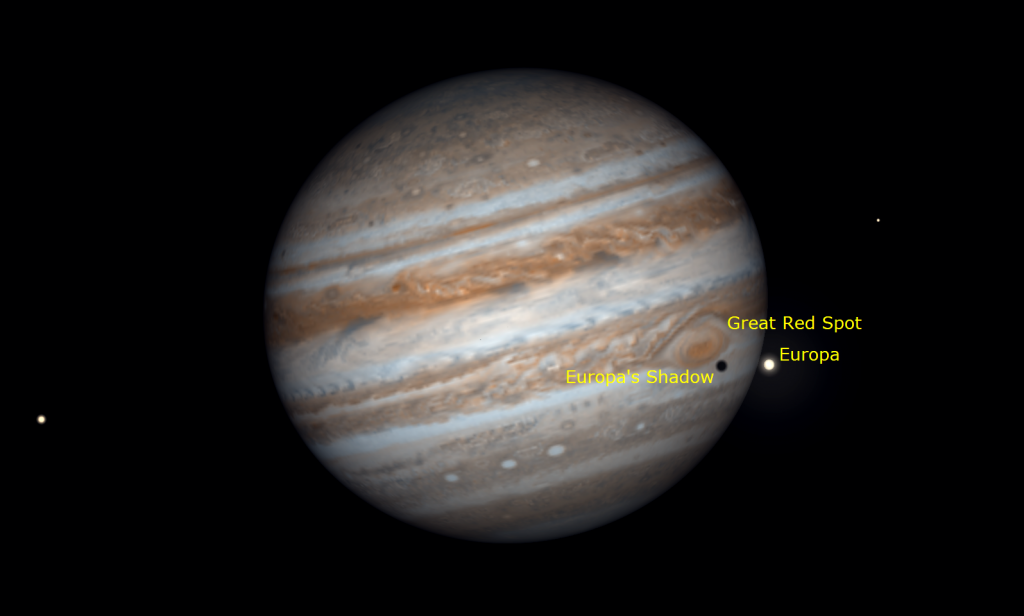
The small, black shadows of Jupiter’s Galilean moons are visible through a good backyard telescope when they cross the planet’s disk. It happens more often around Jupiter’s opposition. Between 12:15 and 2:55 am EDT on Wednesday morning, observers in the Americas with telescopes can watch the large, black shadow of Ganymede cross the southern half of Jupiter’s disk – with the Great Red Spot. For observers in western USA and Canada, Europa’s small shadow will cross on Wednesday morning between 2:35 and 5 am PDT and Io’s shadow will cross on Thursday morning between 2:25 and 4:30 am PDT. Io’s shadow will cross on Friday night between 11:50 pm and 2 am EDT, and Europa’s shadow will cross on Saturday evening (alongside the Great Red Spot!) from 7:50 pm to 8:20 pm ADT. Don’t forget to adjust these quoted times into your own time zone.
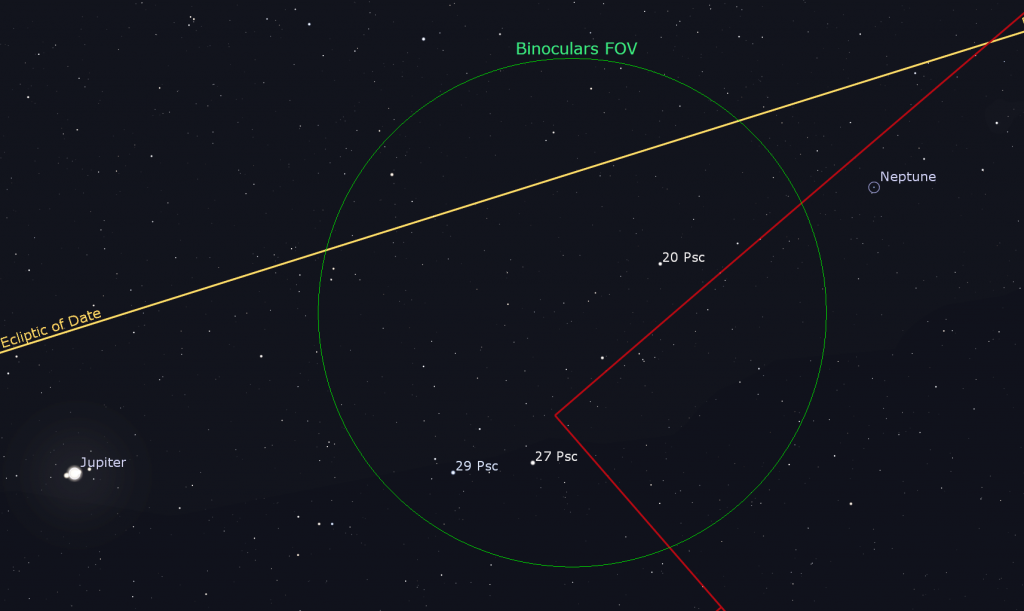
Neptune is positioned in the sky between Jupiter and Saturn. This month, the distant planet’s faint, blue speck will be located a fist’s diameter to Jupiter’s upper right, and two finger widths to the upper right (or 2.6° to the celestial west-southwest) of a small star named 20 Piscium. Neptune is visible all night long in backyard telescopes. Good binoculars will show it, too – if your sky is very dark. Your best views will come after 9 pm local time, when the blue planet has risen higher. Still close to opposition for 2022, Neptune’s apparent disk size is 2.4 arc-seconds and its large moon Triton is still visible.
Uranus is within reach of binoculars in a dark sky, and in any telescope. The blue-green speck of the planet is located a generous fist’s width to the right (or 12° to the celestial southwest) of the Pleiades star cluster. Closer guideposts to Uranus are several medium-bright stars named Botein (or Delta Arietis), Al Butain II (or Rho Arietis), and Sigma Arietis which will appear several finger widths from Uranus. Those stars mark the feet of the Ram, Aries. The magnitude 5.7 planet will be high enough for telescope-viewing, in the lower part of the eastern sky, by 11 pm local time this week.
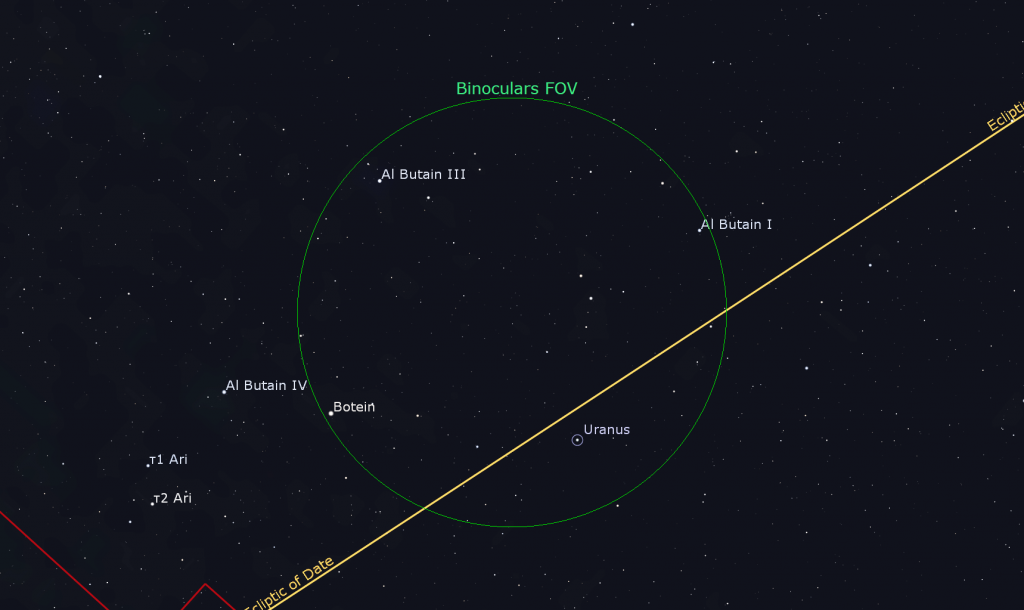
This week, the medium-bright, reddish dot of Mars will rise above the east-northeastern horizon around 10:30 pm local time and will deliver nice views in a backyard telescope after midnight local time. In a telescope, Mars will show a growing, 87%-illuminated disk. Watch for the bright reddish star Aldebaran positioned a fist’s width to Mars’ right (or celestial southwest). Mars will be brightening and growing larger as Earth’s faster orbit draws us closer to it over the coming months. We’re 121 million km (or 6.8 light-minutes) away from it this week.

In the first part of this week, use binoculars to see a large open star cluster designated NGC 1746 sitting a generous thumb’s width above Mars. It will appear as a faint patch of fuzziness. A small telescope will resolve its stars. Each night, Mars will shift farther down to its lower left, but they’ll share the view in binoculars until early next week.

Public Astro-Themed Events
Every Monday evening, York University’s Allan I. Carswell Observatory runs an online star party – broadcasting views from four telescopes/cameras, answering viewer questions, and taking requests! Details are here. They host in-person viewing on the first clear Wednesday night each month. Other Wednesdays they stream views online via the observatory YouTube channel. Details are here.
My free, family-friendly Insider’s Guide to the Galaxy webcasts with Samantha Jewett of RASC National returns on Tuesday, September 27 at 3:30 pm EDT, when we’ll finish our look at variable stars! Plus, we’ll continue with our Messier Objects observing certificate program – autumn objects. You can find more details and the schedule of future sessions here.
On Tuesday evening, September 27 at 7:30 pm EDT, McMaster’s Origins Institute will present a free online public lecture by Dr. Hari Kunduri, Associate Professor in the Department of Physics and Astronomy. His lecture will be titled A (Brief) History of Black Holes. More information and the registration link are here.
On Thursday, September 29 at 7 pm EDT, the College/Shaw branch of the Toronto Public Library will feature a free, in-person public lecture by John Percy, Professor Emeritus at the University of Toronto, in Astronomy & Astrophysics, and in Science Education. He’ll speak on The Amazing Universe! More information is here.
Eastern GTA sky watchers are invited to join the RASC Toronto Centre and Durham Skies for solar observing and stargazing at the edge of Lake Ontario in Millennium Square in Pickering on Friday evening, September 30, from 6 pm to 11 pm. Details are here. Before heading out, check the RASCTC home page for a Go/No-Go call – in case it’s too cloudy to observe.
RASC’s Public sessions at the David Dunlap Observatory will soon be resuming. In the meantime they are pleased to offer some virtual experiences instead in partnership with Richmond Hill. The modest fee supports RASC’s education and public outreach efforts at DDO. Only one registration per household is required. Prior to the start of the program, registrants will be emailed the virtual program link.
On Sunday afternoon, October 2 from 11 am to noon EDT, join me for DDO Ask an Astronomer. During the family-friendly session, I’ll answer your questions about the universe and review what’s up nowadays. The deadline to register for this program is Wednesday, September 28, 2022 at 3 pm. More information is here and the registration link is here.
Keep looking up, and enjoy the sky when you do. I love questions and requests. Send me some!